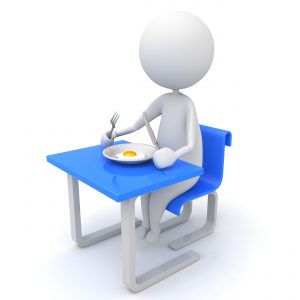The Speech and Language Therapist (SLT), in liaison with other team members, may  need to make recommendations on how to help the person eat and drink safely that extend beyond advice on texture modification in order to support effective and safe eating and drinking.
need to make recommendations on how to help the person eat and drink safely that extend beyond advice on texture modification in order to support effective and safe eating and drinking.
Further strategies that may be used to help the person with dysphagia include advice on:
- Positioning: Where possible the person should be sat upright, be well supported, head tilted slightly forward and feet flat on the floor. Knee and hip joints should be at 90 degree angles. Advice from Physiotherapy and/or Occupational Therapy may be appropriate.
- How to eat e.g. size of mouthful, speed of eating and any prompting the person may need
- Tiring: Following ABI, the person may fatigue rapidly, potentially decreasing their ability to take food/liquid safely. The SLT, in consultation with the dietitian, may recommend smaller more frequent meals or regular small snacks.
- Environmental support for eating and drinking: It can be helpful if distractions are reduced and the person with dysphagia is able to direct their attention to the process of eating or drinking. For people who are unable to manage their own dysphagia safely as a consequence of cognitive difficulties, those caring for them must make sure that the environment is safe. The person should not have unsupervised access to food or liquid if this has the potential to cause risk (e.g. choking, aspiration). Carers must take responsibility to ensure that the person cannot access foods or liquids that could be dangerous for them. This may include making sure unsafe food and liquid is not left out on tables and other patients/residents (if cared for outwith the family home) do not offer unsafe food or a drink to the person with dysphagia.
